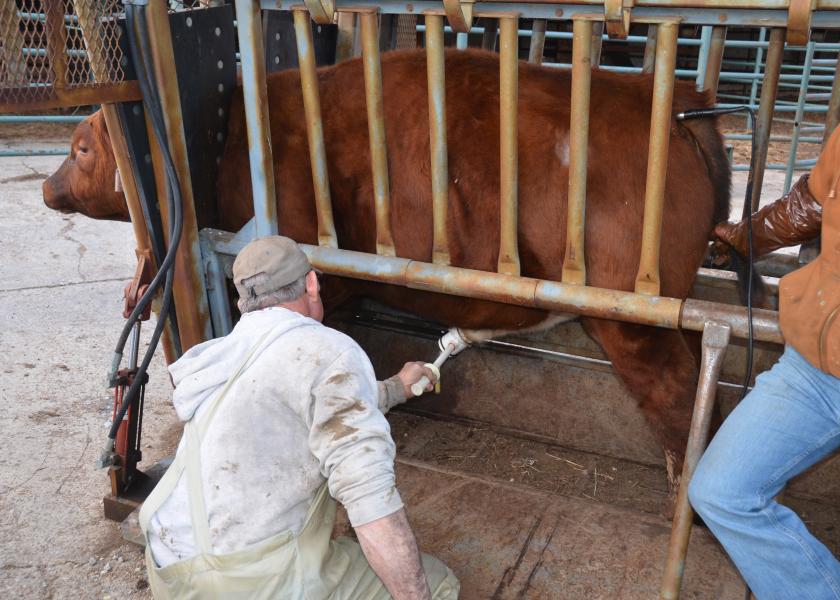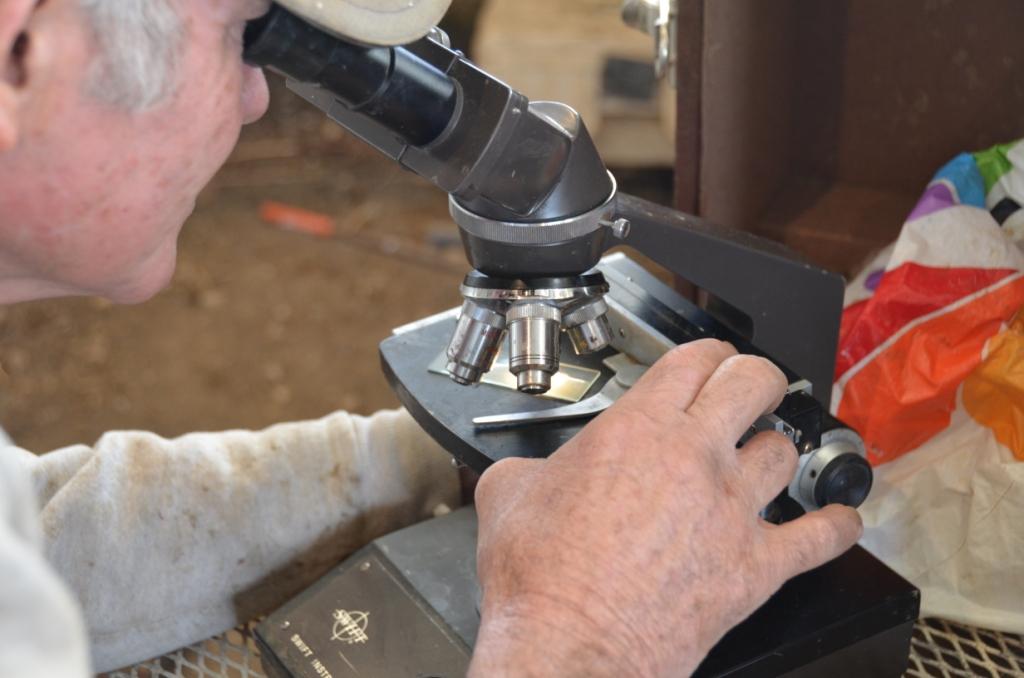Breeding Soundness Exams: Insurance for Bulls

Spring calving has started or is wrapping up around much of the country and it is nearly time to turn bulls out to breed for the next calf crop. Just as important as having a bull with good genetics, is to make sure he can actually perform his job when covering a cowherd or group of heifers. Breeding soundness exams are a vital way to ensure bulls will be fertile and physically sound.
A breeding soundness exam should be performed yearly by a veterinarian before turnout advises Jennifer Koziol, veterinarian and assistant professor at Purdue University.
“Even though we may have done a breeding soundness exam in the past couple of years, there’s no guarantee that something hasn’t changed,” Koziol says.
A bull may have sustained an injury to his penis or has just had a downgrade in semen production that would keep him from getting females pregnant. By getting a breeding soundness exam performed, it takes out the risk of turning out a bull that might be infertile or subfertile.
Weather conditions can impact fertility, and frostbite could be a hindrance to bull fertility in some parts of the country, says Chance
Armstrong, veterinarian and assistant professor at Louisiana State University. Bull sale season is coming to a close and for areas like the
Midwest, Rocky Mountains and northern Plains where adverse weather has been endured for much of winter, having a breeding soundness exam done on those newly purchased bulls should be considered. “With frostbite being a potential issue following extreme winter weather experienced this year, and in particular because of how prolonged it has been, there could be a significant negative effect on testicular function and semen quality,” he adds.
There are four parameters to a breeding soundness exam:
- Physical Examination
- Measuring Scrotal Size
- Evaluation of Semen Morphology
- Evaluation of Semen Motility
Here is what a veterinarian will be evaluating during each portion of the exam:
1. Physical Examination
Bulls will be checked to see if they can walk with no limping and are able to support themselves to breed. Hooves will be examined for problems such as sand cracks, foot rot, etc.
If a producer knows ahead of the exam a bull has been lame, they should inform their veterinarian, Koziol says. This will give the veterinarian the ability to possibly treat any ailments that could be remedied with hoof trimming or antibiotics. If the bull isn’t treatable and likely won’t recover, it would then be culled.
An injury to the penis or prepuce that would keep a bull from breeding would also keep a bull from passing the breeding soundness exam, Koziol adds.
Having bulls in proper body condition matters, too. Armstrong believes that having bulls around a 6 to 7 body condition score on a 9 point scale is the best option because during breeding a bull can be expected to lose 2 body condition scores while out breeding females.
“I want bulls to look like well-muscled athletes, not fat, but ready to work when they go into breeding,” Armstrong says.
Other features that will be examined include eyes, teeth and mouth.
2. Scrotal Measurement
A scrotal circumference measurement will be taken by the veterinarian using a measuring tape.
Starting at 15 months a bull must have a scrotal circumference of at least 30 cm, under parameters set by the Society for Theriogenology, an organization of veterinarians who specialize in reproduction that both Armstrong and Koziol belong to. Every three months, after 15 months of age, the circumference minimum goes up 1 cm, by 24 months old a bull has to be at least 34 cm to pass a breeding soundness exam.
| Scrotal Circumference | ||
| Age of bull | Minimum scrotal circumference | |
| 15 months or younger | 30 cm | |
| 15-18 months | 31 cm | |
| 19-21 months | 32 cm | |
| 22-24 months | 33 cm | |
| 24 months or older | 34 cm | |
“If you think of them like a factory, the bigger the factory the more product that can be produced,” Armstrong says of scrotal circumference’s relationship to semen output.
Research has also proven replacement heifers retained from bulls with larger scrotal circumference will go through puberty earlier, helping improve maternal fertility.
If you are comparing two bulls to purchase, Armstrong says you should use the bull with the larger scrotal circumference, if everything else is even.
During the scrotal circumference measurement, the bull will also have his testicles palpated to see if there are any irregularities.
During a breeding soundness exam sperm cell motility and morphology are both examined after a semen sample has been taken from a bull to determine fertility.
3. Semen Motility
This evaluation looks at the movement of the sperm. Semen must be a minimum of 30% motile.
| Motility | ||
| Gross activity | Individual activity | Rating |
| Rapid swirling | 70% or better | Very good |
| Slower swirling | 50-69% | Good |
| Generalized oscillation | 30-49% | Fair |
| Sporadic oscillation | 30% or less | Poor |
4. Semen Morphology
This evaluation looks at whether sperm cells are normal or abnormal. The total ejaculate must possess a minimum of 70% morphologically normal spermatozoa.
Other Considerations
Armstrong recommends having a breeding soundness exam performed 30 to 60 days prior to the breeding season on every bull, every year. This will give a bull that might have a recoverable injury some time to heal and have another breeding soundness exam performed. It also allows a producer to purchase any replacement bulls should a bull need to be culled.
During a breeding soundness exam a cow-calf producer might also want to have other testing performed for diseases such as trichomoniasis, bovine viral diarrhea virus, anaplasmosis and Johne’s disease, especially if the bull is a new addition to the herd.
Koziol says if you are doing trichomoniasis testing, the bull should be sexually rested, and it might be required in certain states.
The average breeding soundness exam costs between $55 to $65 per bull and depending on the veterinarian the cost can go down based on the volume of animals tested.
Both Koziol and Armstrong believe the benefits of performing a yearly breeding soundness exam outweigh the costs and time it takes to do the exam.
“There is a really nice benefit to cost ratio that for every dollar they spend on their breeding soundness exam they’re going to get somewhere between a $6.50 and $7.00 return on investment,” Koziol says.
Armstrong calls it the “best insurance policy” that a cow-calf producer can have for their herd because open cows won’t be able to pay for themselves. “Could you imagine getting a 40-50% calving rate? That could be catastrophic and put some people out of the business,” Armstrong says.
He advises cow-calf producers to make the exams part of their core herd health plan.
Bulls sustain injuries or can become ill, they age and semen production can degenerate over time. The only way to know how they will perform in the pasture is via an annual breeding soundness exam.








